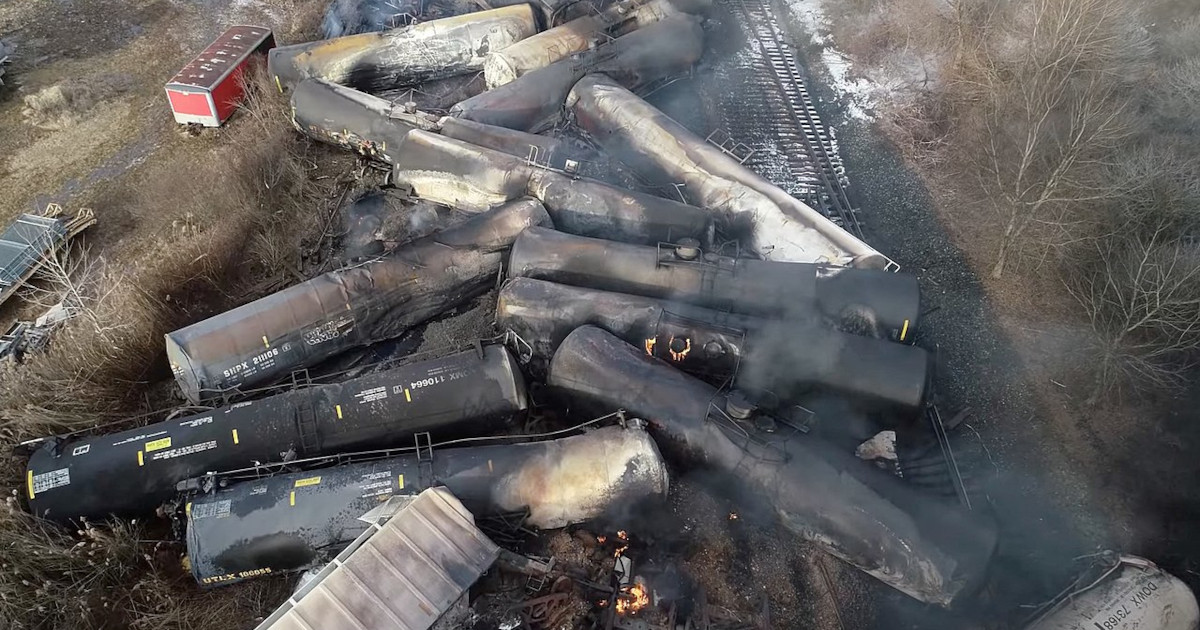Toxic Chemical Residues From Ohio Train Derailment: A Building Contamination Investigation

Table of Contents
Identifying Potential Contaminants from the Ohio Train Derailment
The Ohio train derailment involved the release of several hazardous substances, posing significant risks to both the environment and human health. Key chemicals of concern include vinyl chloride, butyl acrylate, and ethylhexyl acrylate. Understanding these chemicals and their properties is critical to assessing the potential for building contamination.
-
Vinyl Chloride: A colorless gas, vinyl chloride is a known carcinogen, linked to liver cancer, brain tumors, and other serious health problems. Its volatility means it can readily disperse through the air, contaminating indoor spaces.
-
Butyl Acrylate and Ethylhexyl Acrylate: These are acrylic monomers used in paints, adhesives, and coatings. Exposure can cause respiratory irritation, skin sensitization, and eye irritation. Their persistence in the environment and potential for long-term contamination within buildings warrants serious investigation.
These chemicals can contaminate buildings through several pathways:
-
Airborne Dispersal: The initial release created a significant plume of airborne contaminants that could have settled on building surfaces and penetrated indoor spaces.
-
Surface Runoff: Rainfall and snowmelt could carry the chemicals into storm drains, potentially contaminating soil and groundwater, which could then seep into building foundations.
-
Groundwater Infiltration: Contamination of groundwater poses a long-term threat, potentially leaching into basements and affecting indoor air quality through vapor intrusion.
Methods for Assessing Building Contamination after the Ohio Train Derailment
Assessing the extent of building contamination requires a multi-pronged approach utilizing various environmental testing methods. Accurate and comprehensive testing is paramount to determining the level of risk and guiding appropriate remediation strategies.
-
Air Quality Testing: This involves collecting air samples within the building to detect the presence of volatile organic compounds (VOCs) like vinyl chloride. This helps assess the risk of inhalation exposure.
-
Surface Sampling: Surface swabbing or wipe samples are collected from various surfaces (floors, walls, furniture) to identify and quantify the presence of contaminants.
-
Soil Testing: Soil samples around the building's foundation are analyzed to determine the extent of soil contamination and the potential for groundwater infiltration.
-
Water Testing: If there's concern about groundwater contamination, water samples from wells or municipal supplies should be tested for the presence of the released chemicals.
All samples collected undergo rigorous laboratory analysis to accurately quantify the concentration of specific contaminants. Specialized equipment and techniques, such as high-performance liquid chromatography (HPLC) and gas chromatography-mass spectrometry (GC-MS), are employed for precise identification and quantification. A comprehensive contamination assessment and risk assessment are then crucial to determine the appropriate response.
Health Risks Associated with Toxic Chemical Residues in Buildings
Exposure to the toxic chemical residues released from the Ohio train derailment poses significant health risks, both short-term and long-term.
-
Short-term Effects: These may include respiratory irritation (coughing, shortness of breath), skin irritation, and eye irritation.
-
Long-term Effects: Chronic exposure to vinyl chloride, a known carcinogen, carries a significantly increased risk of liver cancer, brain cancer, and other cancers. Butyl acrylate and ethylhexyl acrylate can also cause long-term respiratory problems and other health complications. Neurological damage is also a potential long-term consequence of exposure.
These health risks highlight the urgent need for prompt and effective remediation of contaminated buildings. The potential for long-term health consequences underscores the importance of proactive measures to protect public health and safety.
Remediation Strategies for Contaminated Buildings
Remediation of buildings contaminated with toxic chemical residues requires a carefully planned and executed approach, employing various decontamination techniques depending on the level and type of contamination.
-
Air Purification: Utilizing specialized air filtration systems, such as HEPA filtration, can effectively remove airborne contaminants from indoor spaces.
-
Surface Cleaning and Decontamination: This may involve washing surfaces with appropriate cleaning solutions, followed by thorough rinsing. In cases of severe contamination, more intensive decontamination methods may be necessary.
-
Soil and Groundwater Remediation: Contaminated soil may require excavation and removal or in-situ treatment. Groundwater remediation might involve pump-and-treat systems or other technologies.
-
Hazardous Waste Disposal: All contaminated materials must be disposed of according to strict regulations, ensuring safe handling and environmentally sound disposal of hazardous waste.
Engaging professional environmental remediation services is crucial for effective and safe remediation. These specialists possess the expertise, equipment, and knowledge to implement appropriate strategies, ensuring compliance with all safety regulations and minimizing health risks.
Conclusion
The Ohio train derailment has created a significant risk of building contamination from toxic chemical residues. Thorough investigation, encompassing comprehensive environmental testing and professional remediation, are crucial to safeguard public health and safety. Understanding the potential contaminants, employing appropriate testing methods, and implementing effective remediation strategies are vital in addressing this environmental crisis. The long-term health consequences associated with exposure to these chemicals emphasize the importance of swift and decisive action. If you suspect your building may be contaminated by toxic chemical residues from the Ohio train derailment, contact a qualified environmental remediation specialist immediately for testing and remediation services. Don't compromise your health and safety; prioritize the proper investigation and cleanup of toxic chemical residues to ensure a safe and healthy environment for everyone.

Featured Posts
-
 The Nationwide Anti Trump Protests A Cnn Politics Report
Apr 22, 2025
The Nationwide Anti Trump Protests A Cnn Politics Report
Apr 22, 2025 -
 Us And South Sudan Partner To Manage Deportees Repatriation
Apr 22, 2025
Us And South Sudan Partner To Manage Deportees Repatriation
Apr 22, 2025 -
 Who Will Bear The Brunt Of Trumps Economic Policies
Apr 22, 2025
Who Will Bear The Brunt Of Trumps Economic Policies
Apr 22, 2025 -
 Understanding The Just Contact Us Strategy On Tik Tok To Avoid Tariffs
Apr 22, 2025
Understanding The Just Contact Us Strategy On Tik Tok To Avoid Tariffs
Apr 22, 2025 -
 Over The Counter Birth Control A Post Roe Game Changer
Apr 22, 2025
Over The Counter Birth Control A Post Roe Game Changer
Apr 22, 2025
